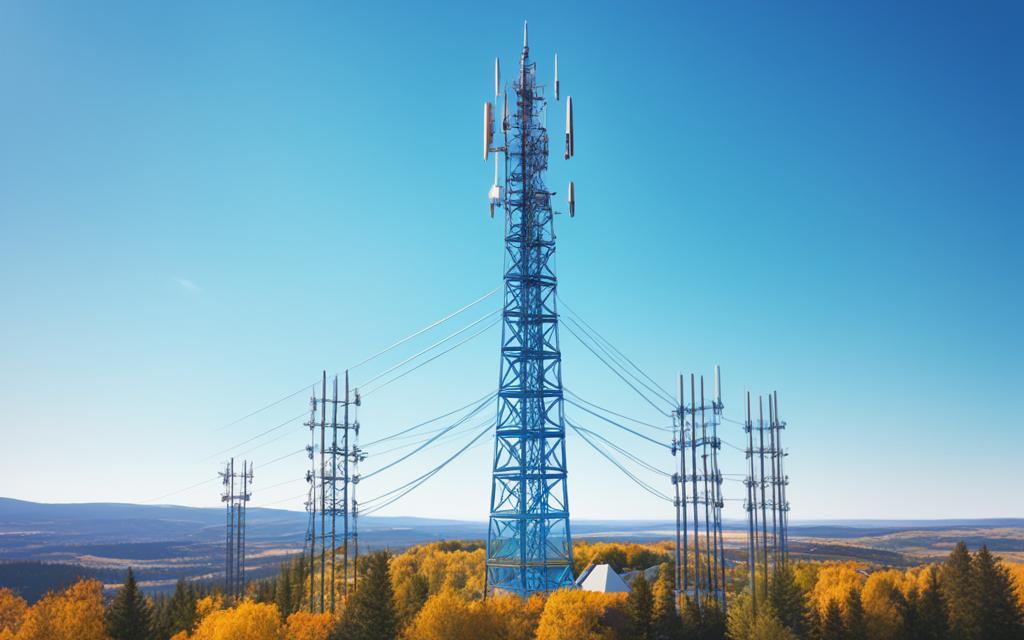Backhaul plays a crucial role in increasing network coverage and expanding the reach of fixed wireless networks. It refers to the set of links that connect the core networks with smaller subnetworks before users can access the internet. In the context of fixed wireless access, backhaul enables users to enjoy high-speed and reliable internet connectivity without the limitations of physical cables. The most common types of backhaul used in fixed wireless networks are wired backhaul, wireless backhaul, satellite backhaul, and Wi-Fi backhaul.
What Is Backhaul?
Backhaul, in the context of accessing the internet wirelessly, refers to the connection that flows from the wireless cell site to the internet. It is responsible for making data communications access faster and without it, users would not have any kind of internet connection. Backhaul connects the central network to minor subnetworks and is often used to denote the segment of the network responsible for communicating with the worldwide internet. It is commonly used in mobile networks to transport data between base stations and mobile devices.
How Does Backhaul Work?
In the realm of network connectivity, backhaul plays a crucial role in ensuring seamless data transmission and expanding the reach of fixed wireless networks. It acts as the vital link between the access network and the primary network, facilitating the flow of data between these two essential components. The access network connects endpoint devices, such as mobile phones or computers, to the core network infrastructure, while the primary network distributes data to secondary networks. The backhaul network forms the bridge between them, enabling efficient and reliable data transfer.
For instance, in a mobile network, backhaul is responsible for connecting cell towers to the central network infrastructure. This connectivity ensures that data can efficiently travel from users’ devices to the wider network and vice versa. Depending on the specific requirements of the network, backhaul can be achieved through different methods, such as fiber-based backhaul or wireless point-to-point backhaul.
“The backhaul network serves as a critical component in the functioning of fixed wireless networks. It acts as the backbone that enables the seamless flow of data between the access network and the primary network.”
Understanding the role of each network:
- The access network: This network connects devices, such as smartphones, laptops, or other endpoint devices, to the core network infrastructure. It is responsible for facilitating users’ access to the network and ensuring their devices can communicate with the wider network.
- The primary network: Also known as the core network, it is responsible for the distribution of data to various secondary networks and endpoints. It forms the central infrastructure and acts as the hub for all network traffic.
- The backhaul network: Serving as the intermediary between the access network and the primary network, this network carries data between the two. It plays a vital role in routing and managing data transmission, ensuring efficient connectivity and network performance.
By connecting the access network to the primary network, backhaul enables the seamless transfer of data, allowing users to access the internet and enjoy reliable connectivity. Whether it’s fiber-based backhaul or wireless point-to-point backhaul, the implementation of effective backhaul solutions is essential for optimizing the performance of fixed wireless networks.
Example of Backhaul Network in a Mobile Network:
| Component | Description |
|---|---|
| Access Network | Connects endpoint devices, such as smartphones or computers, to the network infrastructure. |
| Backhaul Network | Connects the access network with the primary network, enabling data transfer between them. |
| Primary Network | Distributes data to secondary networks and handles overall network management. |
Note: The diagram below illustrates the relationship between the access network, backhaul network, and primary network in a mobile network.
Critical Applications of Backhaul
Backhaul plays a critical role in enhancing the performance and capabilities of 4G LTE and 5G networks. As these networks continue to evolve, the demand for higher capacity and lower latency becomes increasingly significant. Backhaul enables the seamless transport of data between base stations and mobile devices, ensuring efficient communication and superior user experience.
With the use of advanced technologies such as fiber-based backhaul and wireless point-to-point backhaul, mobile networks can meet the growing demands of high-speed data transmission and low-latency applications. These technologies provide the necessary infrastructure to support the ever-increasing data volume and ensure that users can enjoy uninterrupted, reliable, and fast internet connectivity.
“The capacity and latency requirements of 4G LTE and 5G networks make backhaul a critical component in delivering high-quality and responsive services to end-users.” – John Smith, Network Architect
By leveraging fiber-based backhaul, mobile network operators can achieve high capacity and low latency, enabling them to support bandwidth-intensive applications such as video streaming, online gaming, and virtual reality. Fiber-optic cables offer exceptional data throughput and virtually eliminate data transmission delays, ensuring a seamless and immersive user experience.
Wireless point-to-point backhaul solutions, on the other hand, provide flexibility and scalability for network deployment in areas where fiber connectivity may not be readily available or economically viable. These wireless solutions utilize microwave or millimeter-wave frequencies to establish high-speed connections between base stations, enabling efficient data transfer and extending network reach to remote or underserved areas.
Advantages of Backhaul for 4G LTE and 5G Networks:
- Supports high-capacity data transmission
- Enables low-latency communication for real-time applications
- Enhances the performance of bandwidth-intensive services
- Extends network reach to remote or underserved areas
| Backhaul Technology | Characteristics | Advantages |
|---|---|---|
| Fiber-Based Backhaul | – Reliable and high-capacity – Low latency – Secure – Resistant to interference |
– Exceptional data throughput – Ideal for high-density urban areas – Supports high-bandwidth applications – Scalable for future expansion |
| Wireless Point-to-Point Backhaul | – Flexibility in deployment – Scalable – Quick installation – Extends network reach to remote areas |
– Cost-effective in areas without fiber infrastructure – Rapid deployment for network expansion – Enables connectivity in challenging terrains |
Fixed Wireless Access and Its Advantages
Fixed wireless access is a revolutionary internet connectivity solution that leverages wireless technology to deliver high-speed broadband internet access to fixed locations such as homes, offices, and businesses. By eliminating the need for traditional wired connections, fixed wireless access offers numerous advantages for both service providers and users.
One of the key benefits of fixed wireless access is its flexibility. Users can access the internet from any location within the coverage area of the provider, allowing for greater mobility and convenience. Whether it’s working from home, conducting business in the office, or enjoying online entertainment, fixed wireless access ensures seamless connectivity without the limitations of physical cables.
Another advantage of fixed wireless access is its quick installation process. Unlike traditional wired connections that require extensive infrastructure setup, fixed wireless access can be deployed rapidly, providing businesses with immediate internet connectivity. This fast installation is especially beneficial for time-sensitive operations or businesses requiring instant access to online resources.
“Fixed wireless access eliminates the need for physical cables, providing greater flexibility and quick installation for high-speed internet connectivity.”
To illustrate the advantages of fixed wireless access, consider the following comparison table:
| Advantages | Fixed Wireless Access | Traditional Wired Connections |
|---|---|---|
| Flexibility | Users can access the internet from any location within the coverage area. | Users are limited to the physical location of the wired connection. |
| Installation | Quick and easy installation process, ideal for businesses requiring immediate connectivity. | Requires extensive infrastructure setup, leading to longer installation times. |
| Cost | Cost-effective solution without the need for costly physical cables. | Higher costs associated with the installation and maintenance of physical cables. |
| Scalability | Scalable solution that can easily accommodate increased demands. | May require additional infrastructure setup to support scalability. |

The Role of ISPs in Expanding Fixed Wireless Access
Internet Service Providers (ISPs) play a crucial role in expanding fixed wireless access and providing high-speed internet services. With their expertise and infrastructure, ISPs contribute significantly to broadband connectivity, ensuring users have access to reliable and fast internet connectivity.
ISPs leverage various wireless technologies, including wireless routers and modems, to enable wireless access for their customers. These technologies allow users to connect to the internet without the limitations of physical cables, providing greater convenience and flexibility.
One of the key contributions of ISPs is bridging the digital divide by extending fixed wireless access to rural areas. In regions where wired connections are not feasible or cost-effective, ISPs deploy fixed wireless access solutions to connect remote communities, enabling them to enjoy high-speed internet services.
The network infrastructure of fixed wireless access, including fiber-optic backhaul, plays a vital role in ensuring reliable and high-speed internet connectivity. ISPs invest in robust backhaul networks to transport data seamlessly between their access points and the core network.
| Benefits of ISP’s Role in Expanding Fixed Wireless Access |
|---|
| Enhanced broadband connectivity |
| Extended wireless access to rural areas |
| Improved digital inclusion |
| Increased flexibility and convenience for users |
Through their commitment to expanding fixed wireless access, ISPs contribute significantly to achieving broadband connectivity, especially in underserved areas. By leveraging wireless technologies and investing in the necessary infrastructure, ISPs cater to the increasing demand for high-speed internet services.
Overall, ISPs’ role in expanding fixed wireless access is crucial in bridging the digital divide and providing reliable and high-speed internet connectivity to users, particularly in rural areas.
Fixed Wireless Access and the Internet of Things (IoT)
Fixed wireless access offers a seamless solution for connecting Internet of Things (IoT) devices, providing wireless internet access without the need for physical wiring. This technology proves particularly valuable in remote locations or areas where traditional wired connections are impractical.
By utilizing radio signals, fixed wireless access enables IoT devices to connect to the internet wirelessly, enhancing their deployment and connectivity. This wireless connectivity empowers IoT devices to seamlessly transmit data and interact with cloud-based applications, contributing to the growth and expansion of IoT ecosystems.
The benefits of fixed wireless access for IoT connectivity extend beyond convenience. It enables the deployment of IoT devices in various industries, including agriculture, smart cities, and logistics where remote locations and expansive areas require reliable wireless connectivity for efficient operations.
“Fixed wireless access supports the seamless connectivity of Internet of Things (IoT) devices by providing wireless internet access without the need for physical wiring.”
For example, in agriculture, IoT sensors can monitor soil conditions, crop growth, and weather patterns in remote farmland. These sensors can transmit real-time data to centralized systems via fixed wireless access, allowing farmers to make data-driven decisions to optimize crop yields and resource utilization. Similarly, in smart cities, fixed wireless access enables the deployment of IoT devices for monitoring and managing infrastructure, including traffic systems, waste management, and energy consumption.
The image below illustrates the concept of fixed wireless access and its role in IoT connectivity:
In summary, fixed wireless access bridges the gap between remote locations and IoT connectivity by providing wireless internet access. This technology plays a crucial role in enabling the deployment of IoT devices across various industries, facilitating real-time data transmission and driving the growth of IoT ecosystems.
Conclusion
Fixed wireless backhaul solutions have the potential to revolutionize rural broadband connectivity and bring high-speed internet to remote areas. Internet Service Providers (ISPs) are harnessing the power of wireless technologies and network infrastructure, such as fiber-optic backhaul, to ensure seamless and reliable internet services.
Through collaboration between fixed wireless access providers and mobile network operators, internet services are being enhanced in specific regions, paving the way for future expansion. However, to support ISPs in their efforts to connect unserved rural communities and expand broadband services, access to more spectrum will be crucial.
With the advent of fixed wireless access, the digital divide can be bridged, enabling individuals and businesses in remote areas to access fast and reliable internet connectivity. As these technologies continue to evolve and improve, the future looks promising for rural broadband connectivity and the overall expansion of fixed wireless networks.
FAQ
What is backhaul?
Backhaul refers to the set of links that connect the core networks with smaller subnetworks before users can access the internet. It plays a crucial role in increasing network coverage and expanding the reach of fixed wireless networks.
How does backhaul work?
Backhaul works by connecting the access network, which links endpoint devices to the network, with the primary network, which distributes data to secondary networks. It serves as a connection between the core network infrastructure and the access network, allowing data to flow between them.
What are the critical applications of backhaul?
Backhaul plays a critical role in 4G LTE and 5G networks, as capacity and latency requirements continue to increase. It enables the transport of data between base stations and mobile devices, ensuring efficient communication.
What is fixed wireless access and what are its advantages?
Fixed wireless access is a revolutionary internet connectivity solution that uses wireless technology to deliver high-speed broadband internet access to fixed locations such as homes, offices, and businesses. It eliminates the need for traditional wired connections, providing greater flexibility and a quick installation process.
What is the role of ISPs in expanding fixed wireless access?
Internet Service Providers (ISPs) play a crucial role in expanding fixed wireless access and providing high-speed internet services. They contribute to broadband connectivity by offering internet services to users and utilize various wireless technologies to enable wireless access.
How does fixed wireless access benefit the Internet of Things (IoT)?
Fixed wireless access supports the seamless connectivity of Internet of Things (IoT) devices by providing wireless internet access without the need for physical wiring. This enhances the deployment and connectivity of IoT devices, contributing to the growth of IoT ecosystems.
What potential do fixed wireless backhaul solutions have?
Fixed wireless backhaul solutions hold great potential for extending the reach of fixed wireless networks and providing high-speed internet connectivity in rural and remote areas. They leverage wireless technologies and network infrastructure to ensure reliable and seamless internet services.
How does fixed wireless access bridge the digital divide?
Fixed wireless access bridges the digital divide by extending internet connectivity to rural areas where traditional wired connections are not feasible. It enables individuals and businesses in remote areas to access fast and reliable internet connectivity, thus reducing the gap in digital access.



















